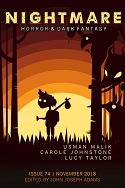 Nightmare #74, November 2018
Nightmare #74, November 2018
“Dead Lovers on Each Blade, Hung” by Usman Malik
Reviewed by Pedro Silva
This issue of Nightmare delivers “Dead Lovers on Each Blade, Hung” by Usman Malik, a novelette in two parts.
Our protagonist, an addict and denizen of Lahore Park—one among the many self-described heroinchis scrounging after the next high—speculates over the park’s latest visitor: the elderly and well-dressed Hakim Shafi. Shafi moves from heroinchi to heroinchi, inquiring after a young woman, proffering her picture to anyone who’ll spare a glance. But Shafi’s inquiries go unanswered till one night, when our protagonist, indulging in newly sourced masala, trips hard in pursuit of his “White Queen.” Crouched in the park’s corner, memories haunt him: of him beating his son “black and blue,” of his son as a runaway, then shortly after, as a victim of street violence, a corpse. It’s in the midst this overdose, while hallucinating his son’s angelic return, that our protagonist is woken by Hakim Shafi, or more precisely, Shafi’s arsenal of medicine.
Grateful for his life, our protagonist follows Shafi to a tidy, old city clinic where Shafi, a medicine man, reveals his specialty: cures derived from snake venom. One venom, it turns out, can ease our protagonist’s withdrawal. Faced with bleak alternatives, our protagonist resolves to kick the habit, repaying Shafi by aiding in the clinic’s daily operations. Soon, however, it’s clear Shafi has other ideas concerning repayment, and he makes a familiar request.
The young woman in the picture is not, as our protagonist supposed, Shafi’s daughter but Shafi’s wife, Maliha, whom Shafi raised since childhood. It was from Lahore Park that she disappeared two years ago, and now Shafi asks that our protagonist talk to his fellow heroinchis; surely they’d respond more openly to one of their own. Confronted with Shafi’s “naked and trembling” love for his wife, our protagonist agrees.
Surprisingly, the scant info he reports back is enough for Shafi to deduce Maliha’s location. She’s in pursuit of the Naag Mani, the serpent pearl—a mythical, glowing stone, which, according to the legends of her desert tribe, awards its owner great power and immortality. “She’s gone to Panjnad,” Shafi declares, resolving to follow; our protagonist, thanks to a quirk of black market politics, finds himself on a kill list and so ventures that splitting town, even if in pursuit of a half-baked MacGuffin, isn’t a half-bad idea.
Their investigation delivers the medicine man and our ex-heroinchi to the shrine of Bibi Farida, where a famous band of qawwals is set to perform. Here, lost amid the music and turbulent, mind-altered crowd, our protagonist loses sight of Shafi only to glimpse a heroinchi using. Feeling once more the call of his “White Queen,” he flees, stumbling through the shrine’s bowels, then finally stumbling upon Shafi himself—and much more: amid the shrine’s depths, Maliha’s legends, the serpent peril, the true “White Queen,” they’re all manifested. They’re just as horrific as they are real.
What begins as a street-wise detective yarn plunges into the supernatural, and what follows climaxes to a satisfyingly grizzly conclusion. The horror takes on a cosmic, existential bent as our protagonist glimpses visions of “strange planets roaming…a vast black cosmos” amid the White Queen’s eyes. The world, he suddenly realizes, lives blissfully unaware of the “biting dark that stretched endless around it.” It may come as little surprise that Shafi is destined for violent ends, yet his shaded, nuanced characterization, particularly in his measured compassion for our protagonist and complicated love for his (once child) wife, make for a sympathetic portrayal and tragic demise. Other characters are portrayed with equal nuance: Maliha, a herpetologist, employs science in chasing childhood myths (e.g., in a standout scene, an excerpt from a letter to a fellow scientist shows this rationalization at work); likewise, our protagonist embodies the familiar archetypal contradiction of the soft-hearted street-thug.
Despite its wealth of well fleshed-out characters, the story seems disinterested in developing relationships between them. The intricacies and compromises of Shafi and Maliha’s marriage, for example, entices with dramatic possibility, yet plays out off-stage in service of the plot. Likewise, Shafi and our protagonist doggedly pursue their mutual quest to its harrowing conclusion, yet spur little change in each other; they appear to recognize only one another’s utility, while nonetheless managing a tensionless relationship.
On the other hand, the story truly succeeds in depicting an alluring setting, rife with aptly chosen detail. Here, Malik transplants tropes (i.e., the detective who stumbles upon cosmic monstrosities) into a landscape of heroinchies, medicine men and cultist qawwals. Also of note, the choice of frame story (i.e., our protagonist recounts the story’s events during a police interview) works especially well at cultivating mystery, while also foregrounding the protagonist’s well-crafted voice against a meaningful, dramatic context.
“Dead Lovers on Each Blade, Hung” presents a mystery that never ceases to be engaging, all while ushering excellently crafted characters quickly, if perhaps too neatly, toward a satisfying finale.